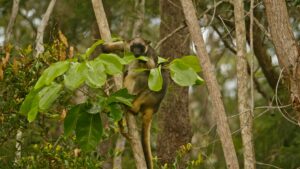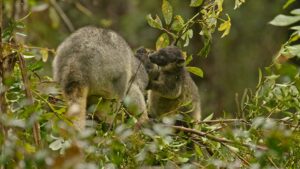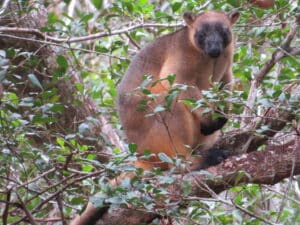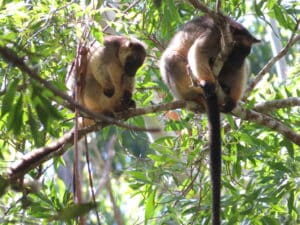One of the most important global meetings on wildlife trade has just wrapped up in Uzbekistan. It’s capital city Samarkand was where governments convened for the 20th Conference of the Parties (CoP20) to the Convention on International Trade in Endangered Species of Wild Fauna and Flora (CITES) to decide how international trade should be managed for some of the world’s most threatened...
 Lumholtz’s tree-kangaroos at Wildlife Land Trust sanctuary White Claw
Lumholtz’s tree-kangaroos at Wildlife Land Trust sanctuary White Claw
Did you know that tree kangaroos are large tree-dwelling marsupials that live across New Guinea and Australia? They spend their lives living in and moving between the canopy of rainforests.
Australia is home to two species of tree kangaroos found in the Wet Tropics region of north-eastern Queensland. Both species have restricted ranges. While the Lumholtz’s tree kangaroo is found in the fertile Atherton tablelands the Bennett’s tree kangaroo is found further north between the Daintree Rainforest and Cooktown.
Are tree kangaroos related to ground-dwelling kangaroos?
Yes! Tree kangaroos belong to the same family group called Macropodidae (macropods), a group of marsupials that also contains kangaroos and wallabies. When deconstructed the name macropod means macro (big) and pod (foot) referring to the long hind feet of species in this family typically used for hopping!
 Lumholtz’s tree-kangaroos at Wildlife Land Trust sanctuary White Claw
Lumholtz’s tree-kangaroos at Wildlife Land Trust sanctuary White Claw
What do tree kangaroos do up in the trees?
Tree kangaroos belong to the genus Dendrolagus, meaning dendro (tree) lagus (hare). Rather than hopping, tree kangaroos leap and bound from branch to branch within the trees with remarkable agility, completing jumps of up to nine metres in distance.
The hind limbs of tree kangaroos have evolved to be smaller, broader, and spongier than those of kangaroos that hop on the ground. Tree kangaroos are also equipped with sharp claws, short muscular limbs and a pendulous tail used as a counterbalance while climbing. They are also the only marsupials capable of controlling their hind limbs independently of each other, allowing them to move backwards, helpful for descending trees.
Unlike most macropods, their diet is quite general and ranges from leaves and fruit to grains, bark and sap. During the day, they sleep hunched on branches high in the canopies, away from predators like dingoes and carpet pythons.

Male Lumholtz’s tree kangaroo at Wildlife Land Trust Sanctuary Dendrophilia Nature Refuge
Are tree kangaroos threatened?
Unfortunately, both Australian tree kangaroo species the Lumholtz’s tree kangaroo and Bennett’s tree kangaroo are classified as Near Threatened under the Queensland Nature Conservation Act 1992.
Major threats to the species are a slow breeding rate and hesitancy to move from their home range, instead choosing to stay in fragmented or disturbed areas rather than move to more intact forests.
The destruction of tree kangaroo habitat has forced populations to live in fragmented areas of rainforest, where they must travel on the ground between trees. This makes them easy targets for dog attacks and vehicle collisions.
Climate change is also expected to further degrade their forests, as cyclones become more frequent and severe, temperatures rise, and water sources diminish.
How can I help protect tree kangaroos?
To protect tree kangaroos, responsible tourism and pet management are important. Visitors and residents of areas where tree kangaroos live should take care when travelling on roads and keep dogs on leashes to prevent them from harming tree kangaroos. Education and spreading awareness about these lesser-known species is also key.
Private landowners are providing and improving essential habitats for wildlife such as tree kangaroos in the Wet Tropics region. Wildlife Land Trust sanctuaries such as Nightwings Rainforest Centre, Daintree Cascades, White Claw and Lake View help to conserve important tree kangaroo habitat, connecting fragmented rainforests and providing sanctuary from predators and human development. Wildlife Trust sanctuaries and accommodation providers Dendrophilia Nature Refuge and Daintree Siesta also offer guests a chance to spot these incredible animals during their stay.

Lumholtz’s tree kangaroos at Wildlife Land Trust Sanctuary Dendrophilia Nature Refuge
Have you ever seen a tree kangaroo? Next time you are in the Wet Tropics of Far North Queensland make sure you take some time to gaze up into the canopy as you might just get lucky!


